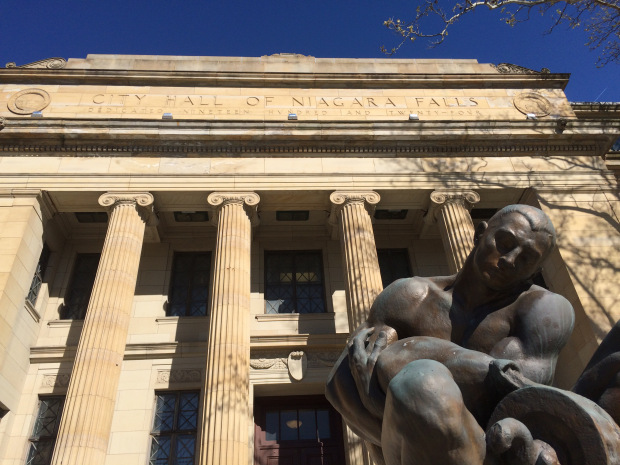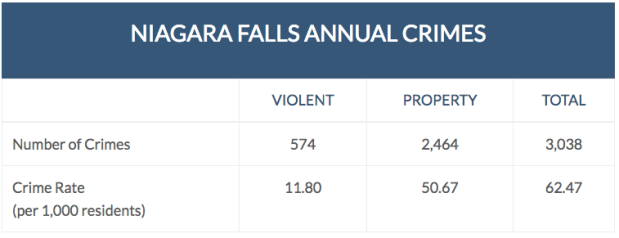
Editor’s note: The following piece is from Sheepie Niagara, a Niagara Falls-based website featuring news, commentary, food and music reviews and more. We’re sharing it with the explicit permission of the cartoon sheep that runs the site.
Niagara Falls’ worst problem is its reputation. We’ve had a branding issue for years, and its continuing to plague us in every aspect of life.
Fun fact: we are apparently more violent than 97% of cities in the United States.
This fact is utterly wrong, and most people living here could probably tell you that. Unfortunately, this same data continues to be spread. It even popped up in Niagara University’s newspaper, which bothers me on a personal level.
The people spreading the data feel justified: it is collected by the FBI after all. Unfortunately, there’s one simple problem with it: math.
Let’s look at that Neighborhood Scout data that everyone keeps using as a base:

The population used as a base for these numbers is 48,632. Based on this, the crime rate for violent crimes is 11.80 per 1,000 residents, and 50.67 property crimes per resident.
According to this data, you have a 1 in 85 chance of a violent crime happening to you, and a 1 in 20 chance of property theft.
People will continue to parade around this number, oblivious to the fact that they are ignoring a very significant factor that the FBI and Neighborhood Scout doesn’t track. The thing that makes Niagara Falls Niagara Falls.
Tourists.
Niagara Falls, USA estimates that around 8 million touristsvisit the Cataract City every year. The number is not definitive, but even the most conservative data estimates at least 5 million people spend time in Niagara Falls.
This is not factored into the FBI’s data.
As you read earlier, the FBI and Neighborhood Scout figure out their crime rates using basic high school math. The total number of crimes is divided by the population, then multiplied by 1000.
Of course, there’s at least 5 million people unaccounted for. Understanding this, we can do some math of our own.

DETERMINING POPULATION:
Niagara Falls has a standard population of 48,632. In addition to this, we have (conservatively) 5,000,000 visitors each year.
Now, this next step is technically incorrect. Niagara Falls has a high and a low season, so the actual number of individuals in the city at any given time fluctuates quite distinctly. However, for the sake of argument, we’re going to use a constant. While this will skew our results, the result will be far closer to reality than the rate created by Neighborhood Scout.
48,632+(5,000,000/365)=BASE POPULATION
48,632+(∼13,699)=BASE POPULATION
48,632+13,699=62,331
Based on our math, Niagara Falls has a technical population of 62,331 on average. Knowing this, we can now recalculate the crime rate.

DETERMINING VIOLENT CRIME RATE:
We know that the number of violent crimes reported in Niagara Falls was 574. Using this number with our new population, we can determine the violent crime rate.
(574/62,331)*1,000=VIOLENT CRIME RATE
(∼0.0092)*1,000=VIOLENT CRIME RATE
0.0092*1,000=9.2
Using our new data, Niagara Falls’ violent crime rate drops to 9.2 per 1,000 people. While this may seem like a little change, it does have a distinct impact. While Neighborhood Scout states that your chances of being the victim of a violent crime are 1 in 85, our data suggests that your chances are actually closer to 1 in 109.

DETERMINING PROPERTY CRIME RATE:
We know that the number of property crimes reported in Niagara Falls was 2,464. Using our new population, we can determine the property crime rate.
(2,464/62,331)*1,000=PROPERTY CRIME RATE
(∼0.040)*1,000=PROPERTY CRIME RATE
0.040*1,000=40
Using our new data, Niagara Falls’ property crime rate drops from 50.67 to 40 per 1,000 people. Instead of 1 in 20, our data suggests that your odds of being a victim of property crime is closer to 1 in 25.
A NOTE ON “PROPERTY CRIME”:
As stated by Neighborhood Scout, property crime is defined as “burglary, larceny over fifty dollars, motor vehicle theft, and arson.” Due to the number of vacant properties within the city of Niagara Falls, this definition can be an issue. Theft and arson of abandoned buildings is an issue in the city, but including them in the property crime calculation is slightly misleading.

WHAT DOES THIS MEAN?
By correcting the data to include tourists, we were able to reveal that Niagara Falls’ crime problem is not as severe as initially reported. While crime is still an issue in the Cataract City, we are far from the “most violent city” in the area.
If the FBI and Neighborhood Scout are skewed so severely, why hasn’t anybody brought it up?
To be honest, people have.
Kevin Wolff, a criminal justice professor at John Jay College in New York, actually discussed this on Boise State Public Radio. Attempting to explain why resort towns in Idaho appear to have a high crime rate, Wolff pointed to the issues with the FBI’s method. It’s a fascinating piece, and I highly recommend checking it out.
So the next time somebody says that Niagara Falls is the most violent city, tell them a sheep quoting a Wolff says otherwise.


